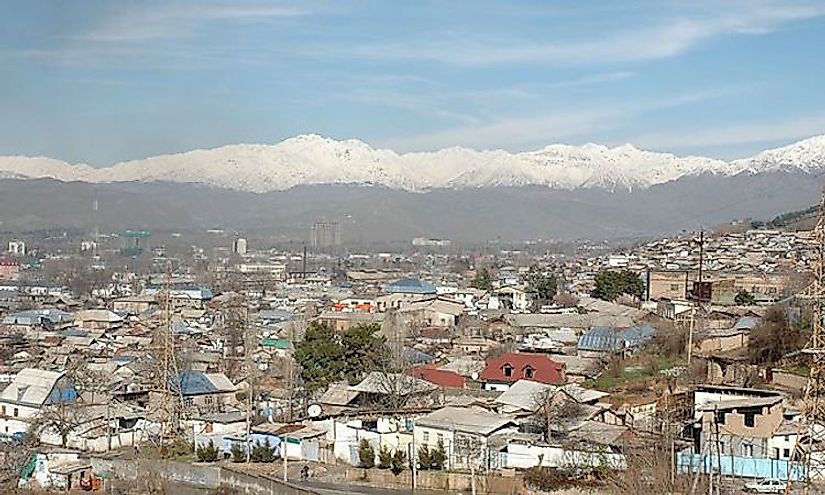Biggest Cities In Tajikistan

Tajikistan is a landlocked country in central Asia bordering four countries including Afghanistan, China, Kyrgyzstan, and Uzbekistan. The country has experienced numerous internal security incidents since 2010, chief among them the armed conflict between the government forces and the local militia made up of criminal groups in Gorno-Badakhshan. Tajikistan remains the poorest of the former Soviet countries. The economy is facing challenges, which include relying on remittances from workers in Russia and the major drug traffickers in the country.
Dushanbe
Dushanbe, Tajikistan's capital and largest city hosts a population of 778,500 people, and between 1929 and 1961 the city was known as Stalinabad. The city is located between rivers Varzo and Kofarnihon. Archaeological findings indicate that the Dushanbe region was inhabited in the 5th century BC. In 1676 there were only 8000 people comprising 500 households living in the area. By 1875, there were almost 10,000 people living in the present day Dushanbe. Today the city of Dusnabe is divided into four districts of Avicenna, Ferdowsi, Ismail Samani, and Shah Mansur. The largest ethnic groups are the Tajiks, Uzbeks, ethnic Russians, and others. The city has numerous sights which are popular with tourists like Tajikistan national museum, Vahdat Palace, Dushanbe Zoo, and the Gurminj. Dushanbe Flagpole is within the city standing at 541 feet (165 m), and it is the world’s tallest free-standing flagpole.
Khujand
Khujand ranks second among the largest cities in Tajikistan and is in the province of Sughd with a population of 169,700 people. The city of Khujand is on the site of the earlier city of Cyropolis that was founded by King Cyrus the Great just before his death. Later Alexander the Great built the city in 329 BC as the farthest Greek settlement and named it Alexandria Eschate and retained its Hellenistic culture to as late as 30 BCE. The city would later become a major staging point on Silk Road and attracted different famous Persian scientists and poets becoming a major cultural hub. In the 8th Century fell under the Muslim conquest and became part of the Umayyad and later Abbasid Caliphates. In the subsequent years, the city was under different empires until 1842 when it was under the rule of Russia and was incorporated into the Soviet Union in 1929 when it was named Leninabad in 1936. It existed as part of the Soviet Union until 1991 when it reverted to its original name after the Soviet Union's breakup in 1992. The city is made of different ethnic groups, and the largest are the Tajiks, Uzbeks, and Russians among others. The major religions in the city include Christianity and Islam.
Kulob
Kulob is the third largest city in Tajikistan located in the district Kulob of Khatlon province. It has an estimated population of 99,700 people. Historians trace the city to 737 AD, but records indicate the city was founded much earlier and the present name could have been adopted about 250 years ago. After Russia had conquered part of central Asia, Tajik Soviet Socialist Republic was created within the USSR in 1929 Kulob city became one of the largest cities in the Republic. In 2006 the city was celebrating its 2700th anniversary. Presently, the city is served by Kulob Airport.
Qurghonteppa
Qurghonteppa is another major city in Tajikistan with a population of 101,600. It is in the Southwestern part Tajikistan in the province of Khatlon, and it is the capital of the province. The population of the city keeps fluctuating with seasons as a result of immigrant workers from Russia. Qurghonteppa and Dushanbe are the most diverse cities compared to other cities in the country like Kulob or Khujand. The ethnic communities in the city include the Tajiks, Uzbeks, Russians, Tatars, Greeks, Kazakhs, and Ukrainians among others. The city suffered much damage during the civil war of 1992-1997 when most Russians left the city. Qurghonteppa International Airport connects the city to other cities in the country and other neighboring countries of Kazakhstan and Russia. The city is a major regional hub for telecommunication and banking industries.
The Urban Problem
More than half of the population in Tajikistan are poor and live on less than $2 a day and poverty is worse in the southern parts of the country because of the widespread lack of employment opportunities. Almost half of the country’s labor force work abroad. Close to half of the population (40%) do not have safe drinking water. As a result of the war, most houses were destroyed during the war, and now slums are sprawling in almost all cities, and crime is on the rise because of lack of employment.
Biggest Cities In Tajikistan
| Rank | City | Population |
|---|---|---|
| 1 | Dushanbe | 775,800 |
| 2 | Khujand | 169,700 |
| 3 | Kulob | 99,700 |
| 4 | Qurghonteppa | 101,600 |
| 5 | Istaravshan | 58,600 |
| 6 | Vahdat | 52,900 |
| 7 | Konibodom | 48,900 |
| 8 | Tursunzoda | 50,900 |
| 9 | Isfara | 45,900 |
| 10 | Panjakent | 40,000 |
| 11 | Khorugh | 28,800 |
| 12 | Yovon | 32,300 |
| 13 | Hisor | 26,200 |
| 14 | Norak | 27,200 |
| 15 | Farkhor | 22,500 |
| 16 | Vose' | 22,400 |
| 17 | Chkalovsk | 31,900 |
| 18 | Hamadoni | 22,300 |
| 19 | Danghara | 24,400 |
| 20 | Somoniyon | 22,100 |











